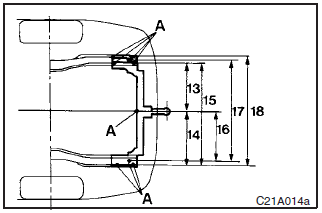Operating hints

(1) Do not let the clutch slip (vehicles with a manual transmission only) and
do not increase the engine speed more than necessary when starting.
(2) Be sure
that the driving speed does not exceed the 100 km/h for trailer operation. It is
also recommended that you obey the local regulations in case driving speed with
a trailer is limited to less than 100 km/h.
(3) To prevent shocks from the overrun
brake, depress the brake pedal lightly at first and then more strongly.
(4) To
make full use of engine braking, change to a lower gear before descending a slope.
(5) The body, brakes, clutch, and chassis will be under additional strain when towing
a trailer.
(6) The heavier weight and higher rolling and air resistance will increase
fuel consumption.
Additional precautions for vehicles equipped with an automatic transmission
The “2” position (INVECS–II 4A/T) or 2nd gear (INVECS–II Sport Mode 4A/T) is recommended on slopes or at low speed. Use the “L” position (INVECS–II 4A/T) or 1st gear (INVECS–II Sport Mode 4A/T) in mountainous areas in order to make better use of engine braking and to assist the brake system. However, be sure that the speed does not exceed the maximum speed limit for the selected gear.
For maximum speed of the vehicles equipped with INVECS–II 4A/T, refer to the description of the “Possible driving speed” on page 5–24.
See also:
Pregnant women restraint
WARNING
• Seat belts work for everyone, including pregnant women. Pregnant women should
use the available seat belts. This will reduce the likelihood of injury to both
the woman and the unborn ...
Instruments
1- Tachometer ®
2- Multi-information display ®
Information screen display list ®
3- Speedometer (km or mph + km/h)
4- Daytime dipper button (meter illumination control) ® ...
To lock or unlock from inside the vehicle
Except for vehicles equipped with the central door lock switch
The rear hatch can be locked or unlocked by using the inside lock knob (driver
side).
1- Lock
2- Unlock
If the rear hatch is lock ...
